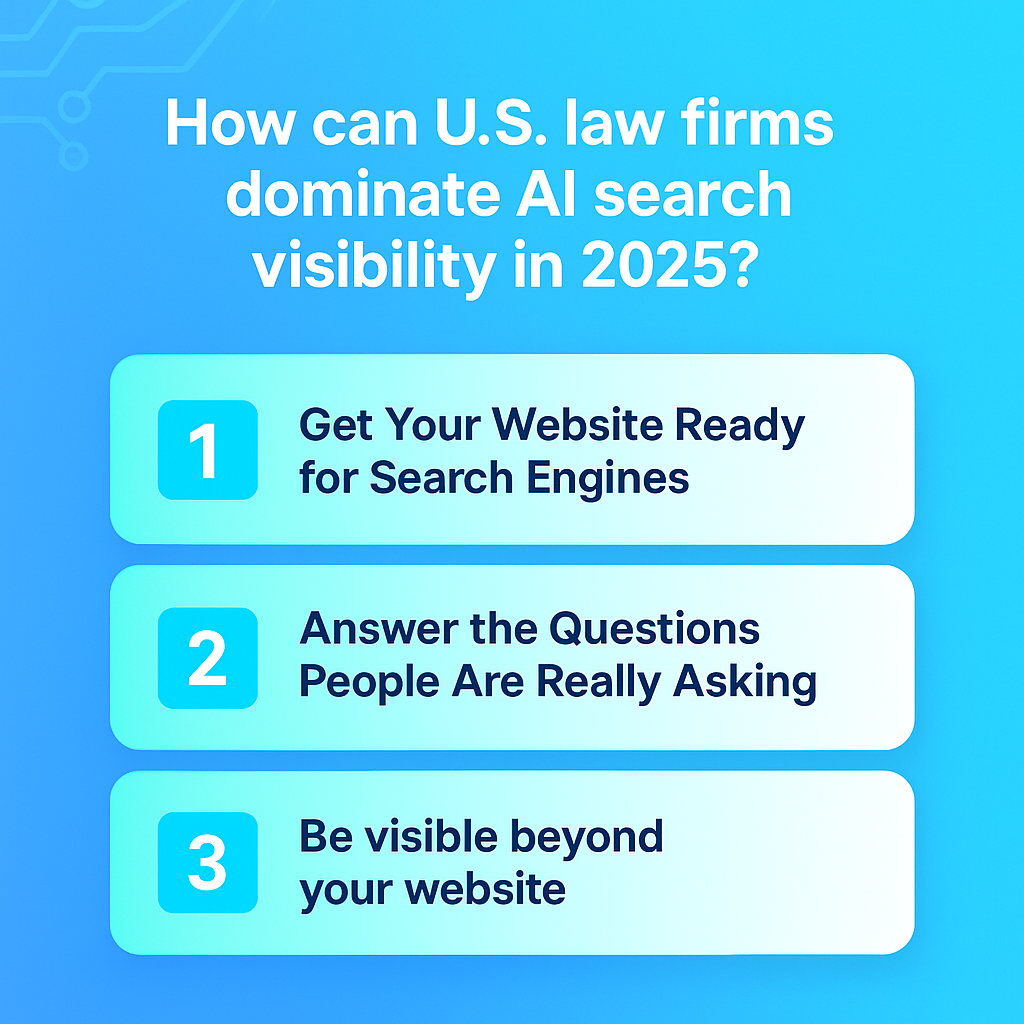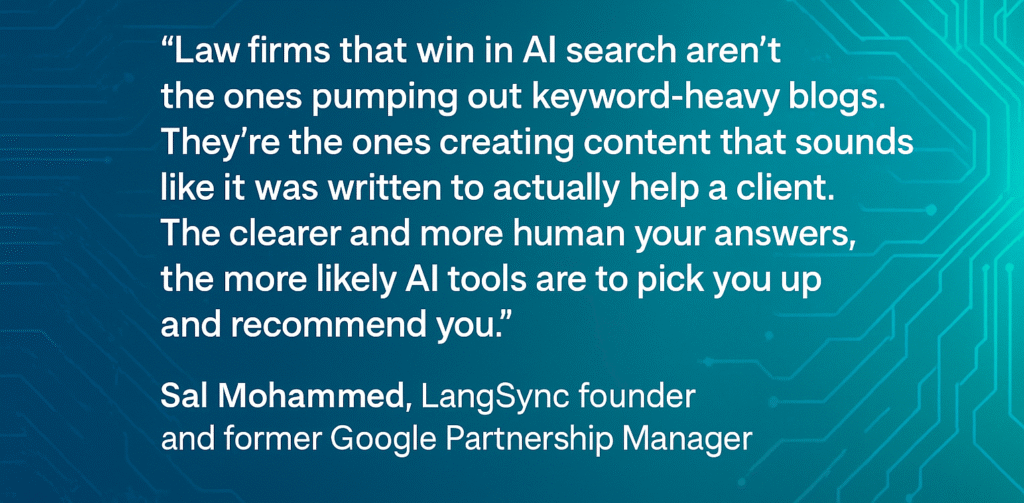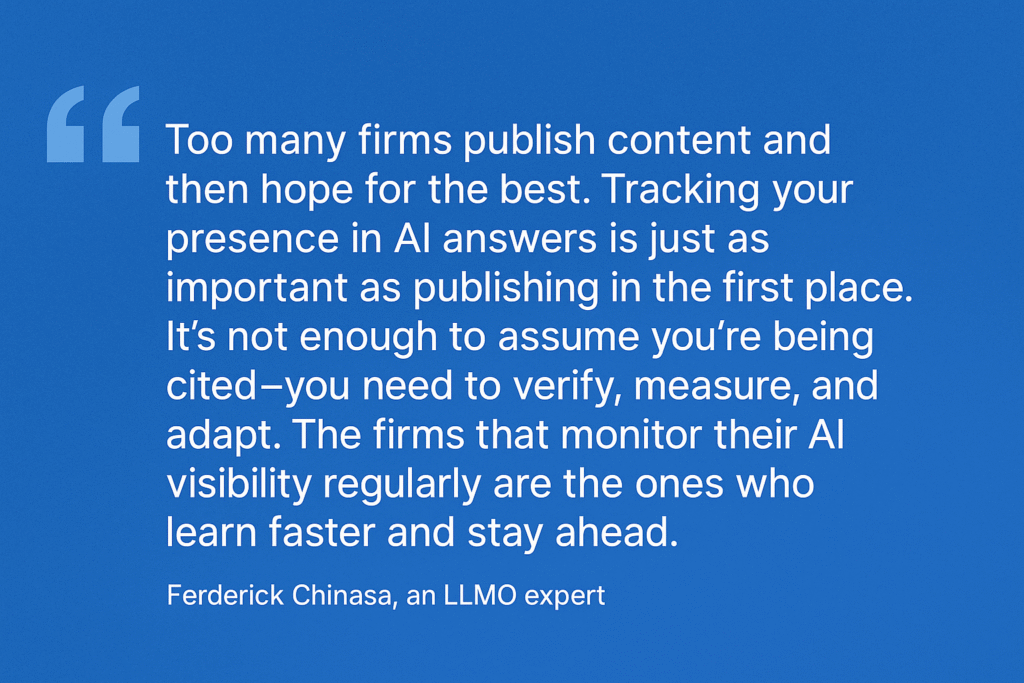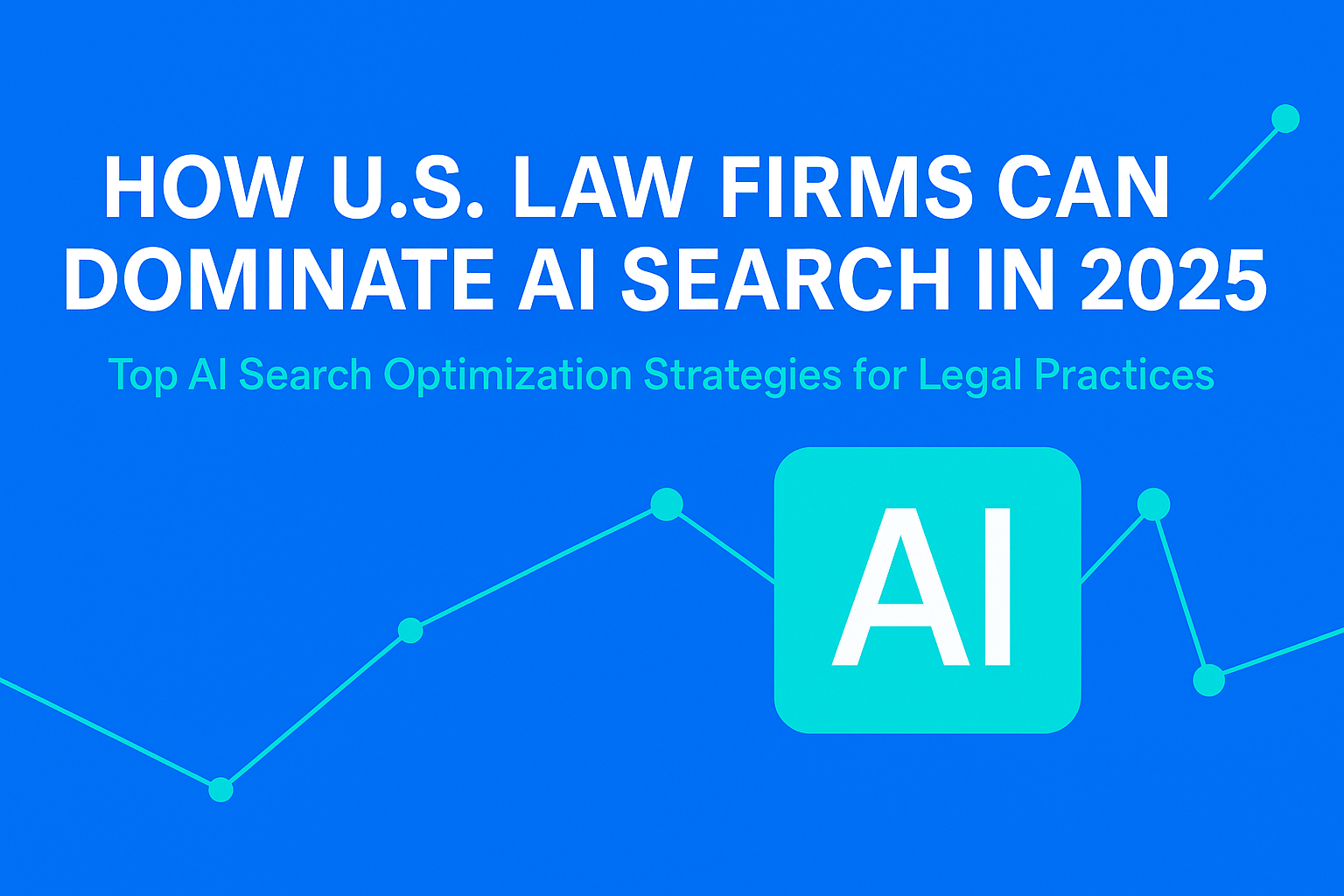Learn how law firms can boost AI search visibility in 2025 with schema, structured content, and platform strategy to stay ahead in legal marketing. Or book a free call to learn how we can help your brand surface in AI answers.
Table of Contents
TL;DR – Want Your Law Firm to Show Up in AI Answers? Start Here.
- Your future clients are skipping Google. They’re asking ChatGPT, Perplexity, and Google’s AI for legal advice and getting one trusted answer. If it’s not yours, someone else is getting that call.
- Winning AI search isn’t about gaming algorithms. It’s about making sure AI tools can find your site, understand your services, and trust your voice.
- Forget keyword stuffing. Write like a real person. AI models favour content that sounds like it was written to help a client, not to climb a ranking. Think FAQs, checklists, plain English, and real answers.
- Don’t just update your blog. Show up where AI listens. That includes legal directories, Reddit threads, Medium posts, LinkedIn explainers, and even Wikidata. Visibility isn’t limited to your website anymore.
- Niche wins. Generic disappears. Go deep on what your firm knows better than anyone else. That’s the kind of content AI tools pick up and potential clients trust.
Let’s face it, getting found online as a law firm isn’t what it used to be.
Not long ago, landing on page one of Google was the gold standard. But today? Clients are skipping search results altogether and heading straight to AI tools like ChatGPT, Perplexity, and Google’s SGE to get their questions answered.
And those tools aren’t serving up ten blue links. As The New York Times recently pointed out, they’re delivering a single, streamlined answer. If your firm isn’t included in that answer, you’re not just losing visibility, you’re losing leads.
At LangSync AI, we help law firms make the leap from “just another listing” to “the trusted source.”
Because if you want AI systems to recommend your practice, three things need to happen:
- They need to find your content
- Understand exactly what it’s about
- And trust that it came from someone credible
That’s where your site’s structure, your content strategy, and your digital footprint all come into play.
How can U.S. law firms dominate AI search visibility in 2025?
Let’s be real, dominating AI search isn’t about gaming an algorithm.
It’s about helping large language models (LLMs) understand exactly who you are, what you do, and why you’re worth citing when someone asks a legal question.
To get there, your law firm needs to work across three main areas:
- Your website’s technical backbone
- The kind of content you’re publishing
- Your visibility and credibility across the internet
Let’s unpack each of them:

1. Get Your Website Ready for Search Engines
You don’t need to be a coder to care about this.
But you do need to make sure your site is clear and organised in a way that AI can process.
That means using something called schema markup. It’s basically a way of labelling different parts of your site so that AI tools know what’s what. For example:
- LegalService tells the AI that you offer legal services.
- FAQPage shows that a page is a list of questions and answers.
- Person helps identify your attorneys.
- Organization describes your firm as a whole.
This kind of labelling is how AI systems separate a random blog post from a credible answer to a legal question.
Also, don’t accidentally block AI tools from accessing your site. Some use crawlers, like Perplexity’s. Make sure your robots.txt file isn’t slamming the door in their face.
2. Answer the Questions People Are Really Asking
Here’s where most law firms miss the mark.
They’re still writing the way they did five years ago, long posts packed with keywords, trying to climb the Google rankings. But that approach doesn’t land with today’s AI tools.
AI systems are designed to answer people’s questions directly. That means your content has to be straightforward, focused, and genuinely helpful.
Picture this:
Someone goes to ChatGPT and types: “How long do I have to file a discrimination claim in California?”
What should your website offer in return?
A short, clear answer: “In California, you generally have one year from the date of the incident to file a state claim. For federal claims, the window can be up to 300 days.”
Not a five-paragraph history of discrimination law. Not a blog post stuffed with synonyms for “employment attorney.”
Just the answer. Clean, honest, and useful.
That’s what AI tools are looking for, and that’s the kind of content that gets picked up and shared when users ask legal questions.
3. Be visible beyond your website.
This is where most firms drop the ball.
It’s not enough to have a good website. You need your name and your answers, circulating in the kinds of places AI trusts. That means:
- Getting listed in legal directories (Avvo, Justia, FindLaw)
- Publishing on platforms like Medium or LinkedIn
- Answering questions on Reddit or Quora
- Having a Wikidata or Crunchbase entry for your firm
Why does this matter?
Because AI models are trained on massive sets of data, and those platforms are often part of it. If you’ve got a solid presence there, you’re more likely to get cited when someone asks a legal question.
You don’t have to be a giant firm. You just have to be present and credible.
What types of content should law firms create for AI visibility?
Here’s the rule: write for the person asking, not the algorithm.
Think about the last time you had a real question about something complicated. You didn’t want a wall of text or a vague answer; you wanted clarity.
Your clients are no different. Whether they’re facing a lawsuit, planning to start a business, or navigating a custody matter, they’re looking for practical, understandable information that helps them take the next step.
As Sal Mohammed, LangSync founder and former Google Partnership Manager, puts it:
“Law firms that win in AI search aren’t the ones pumping out keyword-heavy blogs. They’re the ones creating content that sounds like it was written to actually help a client. The clearer and more human your answers, the more likely AI tools are to pick you up and recommend you.”

In other words, skip the jargon, skip the filler, and focus on content that solves real problems in plain English. That’s the kind of material AI engines and your clients will trust.
1. Start with honest, clear FAQs
FAQs are still one of the best ways to show up in AI results.
But they have to be real. No fluff, no marketing spin. Just answer the actual questions your clients ask every day:
- “Can I sue my employer for emotional distress?”
- “Do I need a lawyer to start an LLC?”
- “What happens if I ignore a subpoena?”
Write your answer like you’d say it in person. Be kind. Be clear. That’s what people and AI tools are looking for.
2. Use lists and checklists.
When someone asks, “What should I do if I’m served with a lawsuit?” they don’t want a lecture. They want a to-do list.
Give them one:
- Read everything carefully
- Don’t panic
- Call your lawyer
- Respond by the deadline
- Don’t talk about the case publicly
That’s the kind of content AI can easily use, and it’s the kind of content your future clients will actually appreciate.
3. Keep each post focused.
One post = one topic. Trying to explain every type of business dispute in one article won’t help anyone.
Instead, break things up:
- “What to do if your business partner breaches your contract”
- “When to dissolve an LLC in New York”
- “The difference between arbitration and mediation in employment law”
Stick to one idea per post. Keep it under 1,000 words if you can. Be specific.
4. Don’t forget about visuals and video.
If you have a good explainer chart or a short video walking through a process, that’s great.
But make sure it comes with the right extras:
- Add alt text to images (so AI can tell what’s in them)
- Use clear, human-readable filenames (like llc-filing-steps.png)
- Include a full transcript for videos (so AI can read the content)
It’s not just about accessibility. It’s about making sure the content is usable by people and machines alike.
5. Share insights only you have
Did your firm do a study on remote work policies and contracts?
Do you track the kinds of claims your clients bring in most often?
If so, publish that data. Even something simple like, “This year, 3 out of 5 of our small business clients updated their employee handbooks for hybrid work”, can become a quotable stat.
AI models love citing numbers. Make sure they’re citing yours.
Where should law firms distribute content for maximum AI discoverability?
This is where most firms make their biggest mistake.
They pour all their energy into their own website and call it a day. But AI models don’t just pull from your blog. They pull from everywhere. So you’ve got to be everywhere.
Here’s where to start:
Your own site (but done right)
Make sure your content is:
- Easy to find (clean URLs, smart navigation)
- Properly llabelled(with schema)
- Updated regularly (freshness matters)
- Connected (use internal links to tie related topics together)
Don’t bury your best info five clicks deep. Put it where people and AI tools can see it.
Platforms AI tools actually read
AI systems don’t read minds. But they do read:
- Medium
- LinkedIn Articles
- Reddit (especially legal and business subreddits)
- Quora
- Substack
If you can answer a real question in a real conversation on those platforms, there’s a good chance it’ll get seen by the tools that matter.
Legal directories that still carry weight
Avvo, Justia, FindLaw, Law.com, they may feel old-school, but they’re deeply entrenched in the AI training mix.
Keep your profiles there fresh. Make sure they link back to your site. Treat them like digital business cards that AI tools will be referencing.
News and press releases
Got something big to share?
Don’t just post it on your blog. Use press release services to get your message picked up by sites that AI tools trust.
If your firm is quoted in a reputable legal publication or mentioned in a story on a high-authority domain, you become part of the AI-visible web.
Wikidata and Crunchbase
If you’re not listed on Wikidata, get on it.
Same with Crunchbase. These structured databases are used by a wide range of AI systems.
When you do get listed, link to those profiles from your website using sameAs in your schema. It helps AI models connect the dots.
How can law firms use schema markup to improve AI discoverability?
Think of schema like little signposts for your website.
Without them, AI tools are left guessing what your content means. But with schema? You’re spelling things out clearly, so the system knows exactly who you are and what you do.
Here are the key ones law firms should focus on:
- FAQPage – Perfect for your legal Q&A sections. Makes it easy for AI to extract common client questions and your answers.
- LegalService – This goes on your service pages. It tells the AI: “Hey, this firm handles estate planning” or “This team focuses on IP law.”
- Person – Use it for your attorney bios. Include things like law school, bar association memberships, and specialisations.
- Organisation– This one wraps your whole firm. Name, contact info, links to social profiles, it’s the big-picture view.
- Review, Award, Event – These show your credibility. Client reviews, industry awards, speaking gigs. Schema helps AI see that you’re trusted in your field.
All of this gets added to your site using something called JSON-LD. It lives in the background; your visitors won’t see it, but AI will.
And here’s a bonus move: use the sameAs property in your schema to link out to your firm’s Wikidata page, LinkedIn, and Crunchbase. These links help AI systems connect the dots between what’s on your site and what’s on trusted platforms.
Bottom line:
Schema helps you stand out not just to search engines, but to the systems building today’s AI answers.
How can law firms track if they’re being mentioned or cited by AI tools?
Alright, you’ve done the work, you’ve added schema, published great content, and you’re showing up in the right places.
But how do you know if it’s actually paying off?
You’ve got two solid options here: the hands-on way and the tool-based way.
As Ferderick Chinasa, an LLMO expert, explains:
“Too many firms publish content and then hope for the best. Tracking your presence in AI answers is just as important as publishing in the first place. It’s not enough to assume you’re being cited—you need to verify, measure, and adapt. The firms that monitor their AI visibility regularly are the ones who learn faster and stay ahead.”

By combining manual checks in tools like ChatGPT and Perplexity with analytics platforms designed for AI monitoring, you’ll have a clearer picture of whether your content is being surfaced—and what you need to adjust.
The hands-on way
This one’s pretty straightforward. Open up ChatGPT, Perplexity, or another AI tool and ask a few questions:
- “What do you know about [Your Firm Name]?”
- “Who are the best criminal defence attorneys in [Your City]?”
- “What law firms handle IP litigation in Texas?”
Try questions that you’d want to be included in, especially ones you’ve answered clearly on your site. If you see your firm mentioned (or even your wording echoed), that’s a great sign.
No mention yet? That’s useful too. It tells you where to double down.
The tool-based way
There are tools out there designed to keep tabs on AI mentions.
A few to try:
- Perplexity Labs – Gives you some insight into what content is surfacing where.
- LLMonitor – Tracks when and how your brand is referenced in AI answers.
- Langfuse – Helps you trace LLM interactions and spot patterns in how your content is being used.
You can also tweak Google Analytics 4 to flag referrals from sites like chat.openai.com or bard.google.com. If someone clicks a link to your firm from inside an AI tool, it’ll show up.
What to do with what you find
If your firm is already showing up, that’s a strong signal you’re on the right track.
Take a look at the content that’s performing, then build on it. Update the language, add examples, and link it to other helpful pages on your site. You’re already in the conversation; now it’s about staying there.
And if you’re not showing up yet, don’t sweat it. This isn’t about quick wins. It’s about building steady visibility over time. Go back to the basics: check your schema, simplify your content, and make sure you’re visible in places AI tools actually learn from. Every small move helps.
What advanced tactics can law firms use to stay ahead in AI search?
Once your foundation is in place, there’s still room to outpace even the most established firms, especially if you’re willing to experiment.
Here are a few forward-thinking moves to keep your firm not just visible, but unavoidable.
Build a public knowledge layer.
You probably already have internal documents, training guides, process checklists, and client FAQs.
The next step is shaping some of that into a structured, public knowledge hub.
This doesn’t have to be fancy. It could be a simple Q&A microsite, a searchable glossary of legal terms, or a categorised collection of legal processes for each state you serve. The key is structure: clear labelling, schema markup, and plain-language explanations. This makes your site a magnet for AI indexing.
To help firms implement these strategies efficiently, AI Work deliver custom AI work models and autonomous agents that can help legal firms automate these processes, streamlining their workflow.
Use AI-native formats
Don’t just write blog posts.
Think about how your content will be chunked, parsed, and reused.
- Turn your legal guides into transcripts
- Break complex answers into bullet-point lists
- Add metadata to infographics and diagrams
This helps AI tools “see” your content the way a legal researcher would. You’re not just publishing for people, you’re formatting for machines, too.
Become part of the training data.
AI tools like ChatGPT and Perplexity are trained on public data.
That means you should publish where they go to learn:
- Reddit (in legal advice threads)
- Quora (for specific legal Q&A)
- Medium and LinkedIn (for thought leadership and explainers)
- Justia, Avvo, Law.com (for practice-level credibility)
The goal is to leave content breadcrumbs across trusted public spaces. Over time, those inputs start feeding back into what AI tools trust and recommend.
Use citations as marketing assets.
If you do get cited in an AI answer, screenshot it.
Use it in a client email, social post, or pitch deck. Frame it as a third-party endorsement. People trust AI tools to be neutral. If they’re quoting your site, that’s a signal of authority worth showcasing.
Even better: build a “Cited in AI Answers” badge for your site. Give prospects confidence that you’re showing up where it matters.
Offer something only you can
Every law firm has a speciality, a local insight, or a case type they know better than anyone else.
That’s your AI edge.
Instead of writing yet another general post on “how to form an LLC,” go deep on:
- “Steps to file an LLC for independent therapists in Michigan”
- “How cannabis dispensaries in New Jersey can stay compliant in 2025”
- “New restrictions on workplace surveillance in California: What employers need to know”
Hyper-specific, hyper-useful. That’s the content AI tools love and cite.
LLMO isn’t just a trend. It’s where legal visibility is headed. And the firms that start now, the ones who get structured, publish clearly, and build trust in the right places, will be the ones showing up when it counts.
Be the source AI trusts: Final thoughts.
AI search isn’t coming; it’s already here.
And legal clients are no longer scrolling through ten blue links. They’re asking questions in ChatGPT, Perplexity, and Google’s SGE… and trusting the answers they get back.
If your firm wants to be part of that answer, now’s the time to act. Get structured. Be specific. Show up where AI is listening.
The most visible firms in 2025 won’t just be the biggest. They’ll be the ones creating clear, trustworthy, and genuinely helpful content. Content only they can only offer.
At LangSync, we work with law firms that want to lead, not follow. Whether you’re just getting started or ready to scale your AI presence, we’re here to help.
Or book a free call to learn how we can help your brand surface in AI answers.
